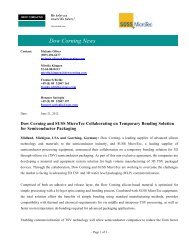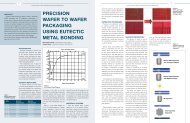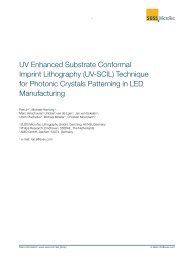The Role of Wafer Bonding in 3D Integration and ... - SUSS MicroTec
The Role of Wafer Bonding in 3D Integration and ... - SUSS MicroTec
The Role of Wafer Bonding in 3D Integration and ... - SUSS MicroTec
You also want an ePaper? Increase the reach of your titles
YUMPU automatically turns print PDFs into web optimized ePapers that Google loves.
2<br />
<strong>The</strong> <strong>Role</strong> <strong>of</strong> <strong>Wafer</strong> <strong>Bond<strong>in</strong>g</strong> <strong>in</strong> <strong>3D</strong> <strong>Integration</strong><br />
<strong>and</strong> Packag<strong>in</strong>g<br />
James Hermanowski <strong>and</strong> Greg George<br />
<strong>SUSS</strong> <strong>MicroTec</strong>, Inc.<br />
228 Suss Drive<br />
Waterbury Center, VT 05677<br />
Abstract<br />
<strong>The</strong>re are numerous process <strong>in</strong>tegration schemes currently <strong>in</strong> place for the implementation <strong>of</strong> <strong>3D</strong>-IC. Via first, via middle, via<br />
last along with back end <strong>of</strong> l<strong>in</strong>e (BEOL), front end <strong>of</strong> l<strong>in</strong>e (FEOL) <strong>and</strong> other variations <strong>of</strong> these approaches. This work will<br />
explore the role <strong>of</strong> wafer bond<strong>in</strong>g, both permanent <strong>and</strong> temporary, <strong>in</strong> the fabrication <strong>of</strong> <strong>3D</strong>-IC. Additionally, the materials <strong>and</strong><br />
process flows used for these processes will be exam<strong>in</strong>ed <strong>in</strong> detail.<br />
I. Introduction<br />
<strong>3D</strong> <strong>Integration</strong> <strong>and</strong> Packag<strong>in</strong>g are currently<br />
described as “paradigm shifts”, “revolutionary<br />
technologies”, <strong>and</strong> other equally prophetic catch<br />
phrases. <strong>The</strong> realization <strong>of</strong> <strong>3D</strong> to meet <strong>and</strong> exceed<br />
these expectations requires significant advances <strong>in</strong><br />
surface preparation methods (CMP – chemical<br />
mechanical polish<strong>in</strong>g), development <strong>of</strong> metal fill<br />
technologies (TSV – through silicon via etch, plat<strong>in</strong>g,<br />
<strong>and</strong> vapor deposition), redistribution layers,<br />
<strong>in</strong>terposer technology, <strong>and</strong> micro bump<strong>in</strong>g methods,<br />
advanced permanent bond<strong>in</strong>g methods, th<strong>in</strong> wafer<br />
h<strong>and</strong>l<strong>in</strong>g (materials, carriers, bond<strong>in</strong>g <strong>and</strong> debond<strong>in</strong>g),<br />
as well as simulators (architectural design to cost <strong>of</strong><br />
ownership model<strong>in</strong>g). <strong>The</strong> complexity <strong>of</strong> <strong>3D</strong><br />
<strong>in</strong>tegration <strong>and</strong> packag<strong>in</strong>g blurs the l<strong>in</strong>e between<br />
process node del<strong>in</strong>eation <strong>and</strong> requires an overall<br />
evaluation <strong>and</strong> underst<strong>and</strong><strong>in</strong>g <strong>of</strong> the entire process<br />
flows. All downstream processes are affected by the<br />
methods used prior to actual <strong>in</strong>tegration process<strong>in</strong>g.<br />
<strong>Wafer</strong> level bond<strong>in</strong>g is a key step, if not the<br />
fundamental step, <strong>in</strong> the success <strong>of</strong> <strong>3D</strong>. If the<br />
stack<strong>in</strong>g <strong>of</strong> the devices is not successful all the<br />
previous <strong>and</strong> subsequent steps are moot.<br />
<strong>The</strong> ultimate goal <strong>of</strong> <strong>3D</strong> is the flow <strong>of</strong> electrical<br />
signals between layers. This can be at the transistor<br />
level between memory layers as <strong>in</strong> <strong>3D</strong> ICs, or it can<br />
be at the packag<strong>in</strong>g level between the various<br />
heterogeneous devices e.g., logic controller to MEMS<br />
device. Permanent wafer bond<strong>in</strong>g methods used <strong>in</strong><br />
<strong>3D</strong> <strong>in</strong>volve metal bond<strong>in</strong>g or hybrid approaches with<br />
metal <strong>and</strong> dielectric layers. <strong>The</strong> most <strong>of</strong>ten used<br />
materials are Cu <strong>and</strong> CuSn for <strong>3D</strong> ICs <strong>and</strong> Au, Al, or<br />
Cu based eutectics for hermetic packag<strong>in</strong>g <strong>and</strong> micro<br />
bump<strong>in</strong>g. <strong>The</strong> process flows, requirements <strong>and</strong><br />
specification requirements for each bond<strong>in</strong>g<br />
technology are based on st<strong>and</strong>ard metrology metrics<br />
but the requirements for high yields are specific for<br />
each technology <strong>and</strong> will be discussed.<br />
Equally essential to the success <strong>of</strong> <strong>3D</strong> <strong>in</strong>tegration<br />
<strong>and</strong> packag<strong>in</strong>g is the ability to reta<strong>in</strong> f<strong>in</strong>al stack<br />
dimensions that meet the application form factor. For<br />
example, it would be unwise to promote vertically<br />
stacked devices that resulted <strong>in</strong> a “chip” that was<br />
several millimeters thick when the applications<br />
require the devices to fit <strong>in</strong>to smaller <strong>and</strong> smaller<br />
spaces. To facilitate stack<strong>in</strong>g, m<strong>in</strong>imize the vertical<br />
<strong>in</strong>terconnect length, <strong>and</strong> achieve form factor<br />
requirements it is common to th<strong>in</strong> each layer <strong>in</strong> the<br />
stack to 50μm or less. <strong>The</strong> development <strong>and</strong> f<strong>in</strong>e<br />
tun<strong>in</strong>g <strong>of</strong> temporary adhesives, the support substrate<br />
options, <strong>and</strong> the quality <strong>of</strong> the debond <strong>and</strong> th<strong>in</strong> wafer<br />
transfer robustness are all advanc<strong>in</strong>g toward high<br />
volume manufactur<strong>in</strong>g options. <strong>The</strong> lead<strong>in</strong>g<br />
technology choices for TWH with compatibility<br />
tables will be provided to assist <strong>in</strong> the selection<br />
process for various types <strong>of</strong> device applications.<br />
II. <strong>Bond<strong>in</strong>g</strong> Sequences for <strong>3D</strong>-IC<br />
<strong>The</strong> n<strong>in</strong>e major <strong>3D</strong>-IC process flows are shown <strong>in</strong><br />
Table 1. In every case, a permanent bond<strong>in</strong>g step is<br />
required to form the <strong>3D</strong>-IC. Almost all <strong>of</strong> the bonds<br />
are metal to metal <strong>and</strong> five out <strong>of</strong> n<strong>in</strong>e <strong>of</strong> the<br />
processes call for temporary bond<strong>in</strong>g to a h<strong>and</strong>le<br />
wafer followed by wafer th<strong>in</strong>n<strong>in</strong>g.<br />
More <strong>in</strong>formation: www.suss.com/tec_library E-Mail: <strong>in</strong>fo@suss.com





